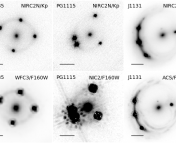Title: A Standard Ruler at Cosmic Dawn
Author: Julian B. Muñoz
First Author’s Institution: Harvard University
Status: Open access on arXiV
You’ve heard of BAOs, now get ready for VAOs
Baryon acoustic oscillations (BAOs) are a well-understood phenomenon in the early universe. When baryons decoupled from photons, a baryon-photon pulse shot throughout the universe at 170,000 km/s, much as sound propagates via fluctuations in air pressure—hence the name “acoustic oscillations.” At recombination, the baryons screeched to a near-halt of 6 km/s, leaving a signature at the distance they traveled in that time. This is the acoustic scale.
But there’s an epilogue to this story. After recombination, there was still a supersonic relative velocity between baryons and dark matter, of about 30 km/s (Mach number ~5). This difference in velocity also fluctuates, in turn producing acoustic oscillations. This effect is dubbed velocity-induced acoustic oscillations (VAOs).
VAOs were first pointed out in 2010, and today’s paper probes them by adding their effect to a modern, public 21-cm code. In a companion paper the author describes the results of these simulations, and in today’s paper they show that VAOs can be used as a new “standard ruler” in the early universe.
A wiggle in early times
The relative motion between baryons and dark matter causes matter density perturbations to smooth out, because at small scales this motion overwhelms the gravitational pull. This means that fewer dark matter halos will form. Moreover, the dense cores of these halos have a harder time developing, so star formation is delayed until gas has time to collect in the cores. These effects leave an imprint on the first star-forming galaxies, both delaying and suppressing their formation. We can’t see these very early galaxies directly, but we can probe them via the 21-cm hydrogen line.
Most 21-cm simulation codes ignore this relative velocity effect. The author of today’s paper implemented it in the public code 21cmFAST, creating 21cmvFAST. With this they ran simulations to track how relative velocities affect the 21-cm map from z~15-30 (where z means redshift and higher values are further back in time). As expected, they found that initial star formation is delayed by Δz=2, pushing back the entire early-universe timeline.
The effect during the more recent Epoch of Heating (z~17) is subtle but noticeable by eye in the simulations. Regions with large relative velocities between baryons and dark matter suppress star formation, producing less X-ray heating and a lower 21-cm brightness temperature, as shown in Figure 1. You can see that areas of higher velocity decrease the temperature fluctuations compared with the no-relative-velocity case.

Figure 1: The 21-cm simulation including relative velocity effects. The top left plot shows the initial density distribution (redder is denser), and the top right shows the initial relative velocity field (redder is high, bluer is zero). The bottom row shows the 21-cm brightness temperature fluctuations at z=17.2 in the no-relative-velocity case (left) and including relative velocity (right). Upper panels of Figure 9 in the companion paper.
Once we have our 21-cm map, we can compute its power spectrum to understand how the intensity depends on scale. The author computes this for the simulation at z=16.1 (Figure 2), and voilà—we see clear oscillations at the expected scales!

Figure 2: The 21-cm power spectrum computed from simulations at z=17.1 (black line). VAOs are clearly visible. Error bars are for projected observations from HERA (explained below). Figure 2 in the paper.
A ruler for the toddler universe
The acoustic scale is a powerful tool for measuring the universe. BAOs give us tick marks on our cosmic ruler in the Cosmic Microwave Background (CMB) when the universe is a baby (z~1100), and in large galaxy surveys when the universe is a full-fledged adult (z~2).
VAOs provide a data point in between these, when the universe is a toddler (z~16). The separation between the VAO peaks in Fourier space corresponds to the acoustic scale, as they are sourced by the same phenomenon as BAOs. From this measurement, one can derive the Hubble expansion rate H(z) and the angular diameter distance at that redshift.
The author uses the power spectrum of their simulations (e.g. Figure 2) to compute projected measurements of H(z) for the Hydrogen Epoch of Reionization Array (HERA), which will map out the 21-cm universe. They find that in all cases, besides their most pessimistic scenario, HERA should be able to detect VAOs. Most optimistically, they predict a 0.3% error on their measurement of H(z), which is competitive with our current best CMB measurements. This projection is shown in Figure 3, alongside other existing and projected measurements at various redshifts. It falls within the predicted uncertainty from CMB measurements, which is in tension with the late-time SH0ES value.

Figure 3: Existing and projected measurements of the Hubble expansion rate as a function of redshift. This work’s projected HERA measurements (red points) fall within the CMB measurement uncertainty (grey band). Figure 1 in the paper.
Today’s paper has shown that VAOs are important for understanding the early universe. They could provide a new standard ruler, filling in a wiggle-shaped gap along the cosmic distance ladder.




